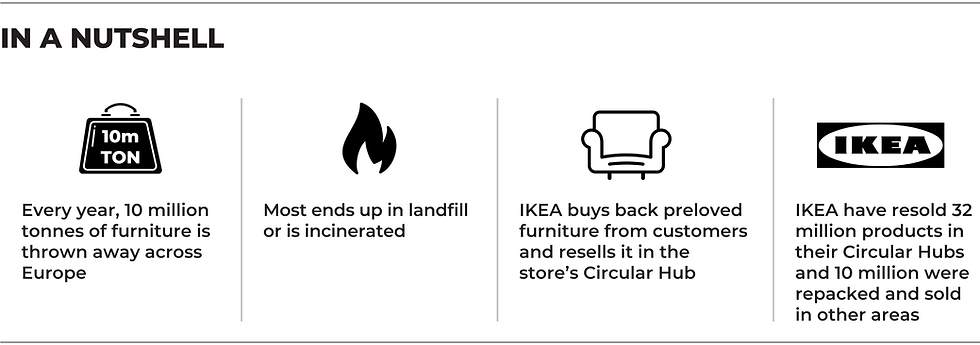
CIRCULÉIRE NON-MEMBER CASE STUDY
COMPANY: IKEA
WEBSITE: IKEA.COM
SECTOR: BUILT ENVIRONMENT
PUBLISHED: 14 JULY 2025
TAGS: RETURN, REUSE, RECYCLE, TAKE-BACK, SECOND LIFE, FURNITURE

About IKEA
IKEA is a home furnishing retailer founded in Sweden in 1943. As of July 2025, there were 486 stores worldwide, serving millions of customers. IKEA has been measuring their climate footprint and setting goals to minimise their environmental impact since the 2016 financial year (FY).
The Challenge
Every year, 10 million tonnes of furniture is thrown away by businesses and consumers across Europe, and most of this either ends up in landfill or is incinerated (Forrest et al., 2017). The fast furniture industry is wasteful, resource-intensive and polluting. In the EU, furniture waste accounts for more than 4% of the total municipal solid waste (MSW) stream (Forrest et al., 2017).
According to IKEA’s FY24 Sustainability Report, their climate footprint is estimated to be equivalent to 21.3 million tonnes CO2 (IKEA, 2024). This represents a decrease of 5% compared to their FY23 report and 28% compared to their FY16 baseline but it’s still equivalent to approx. 5.6 coal-fired power plants’ emissions in a year (EPA.gov, 2025). IKEA’s report also highlights that the majority of their climate footprint comes from raw material extraction and processing (52%) and their product use in customers’ homes (17%), which includes
the energy consumption of lighting and appliances over the product’s lifetime (IKEA, 2024).
The Circular Solution in Practice
IKEA’s Buy Back & Resell Programme is designed to increase the number of times a piece of furniture is used before being recycled or sent to the landfill. IKEA buys back eligible preloved items from customers and resells these good quality second-hand pieces in the store’s Circular Hub section. Aside from second-hand items, the Circular Hub also offers ex-display products and discontinued furniture.
To avail of this service, customers can fill out a form on IKEA’s website, to estimate the furniture’s buy-back value. Then they must bring their assembled IKEA furniture, together with the estimate, to an IKEA store. An IKEA worker will inspect the furniture before accepting it and giving the final agreed value as an IKEA gift card. The Buy Back Program is available in 28 countries, including Ireland, the United Kingdom, the United States of America, Canada, Japan and Italy.
Impact
The Buy-back scheme helps IKEA in cutting their carbon footprint by reducing the amount of virgin raw material inputs required for their products. This can be fulfilled through closing the product loop by facilitating appropriate recycling after multiple uses. In addition, this scheme can contribute to promote the repair concept, by making all the different components of furniture available for purchase separately. Sometimes, the smaller parts (such as dowels, screws, washers, etc.) can be obtained free of charge at the stores. Furthermore, through this scheme, accessible and affordable furniture will be available for low-income households. During IKEA's 2024 Buyback Friday campaign alone - an alternative to Black Friday - almost 55,000 IKEA products were returned to stores for resale (IKEA, 2024).
Replicability
The European Union (EU) manufactures almost one-quarter of the world’s furniture, constituting an €84 billion market (Forrest et al., 2017). Consumers are becoming more concerned about the environmental impact of the goods they buy. Moreover, government regulations such as the EU Eco-design for Sustainable Products Regulation
(ESPR) are pushing for eco-design criteria for products to greatly enhance their circularity, energy performance, and other aspects of environmental sustainability. Businesses will be required to provide product information from conception to end-of-life for almost all physical goods placed on the EU market.
IKEA is serving as an industry pioneer in circular concepts by offering its Buy Back Programme. Businesses can be drawn to this scheme because it can increase profitability by decreasing the cost of production. Furthermore, it can be replicated to a variety of industries such as home appliances, electronics, and textiles.
Among the Irish stores in the circular furniture industry are:
Finline Furniture, take back old Finline sofas and give them a makeover. reducing the number of sofas going into landfill. Their upcycled sofas are striped down, re-padded, re-sprung, re-foamed and re-upholstered before being resold good-as-new. for a fraction of the price.
Rediscover Furniture, is a furniture restoration and upcycling social enterprise housed at the Rediscovery Centre in Ballymun, Dublin.
Walsh’s Furniture Repair & Assembly specialises in in repair of upholstery, leather, timber, and furniture assembly.
